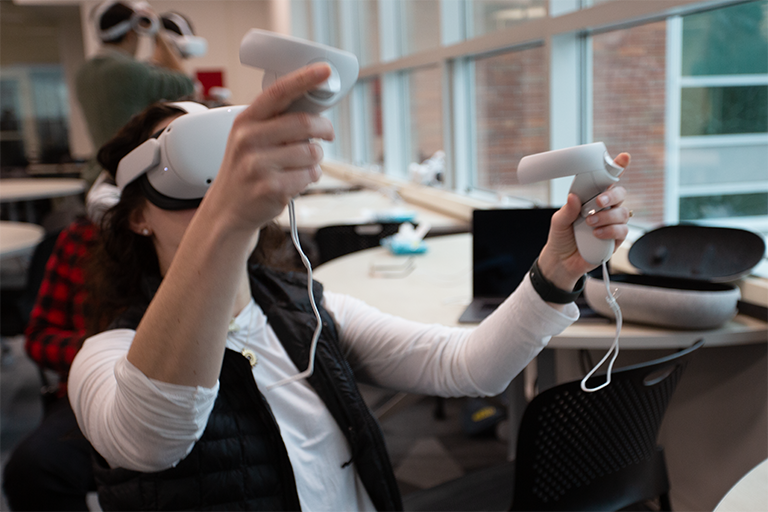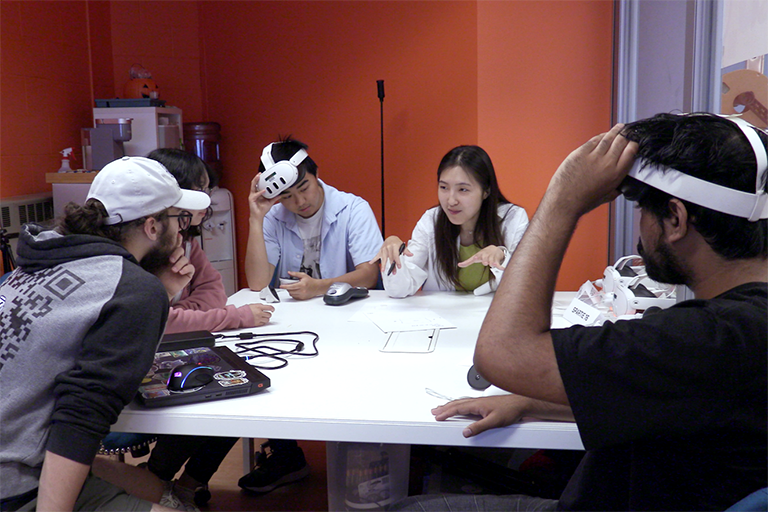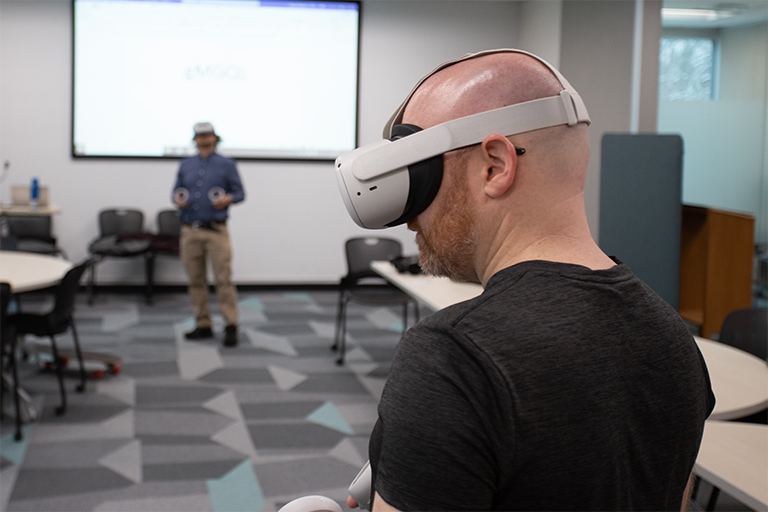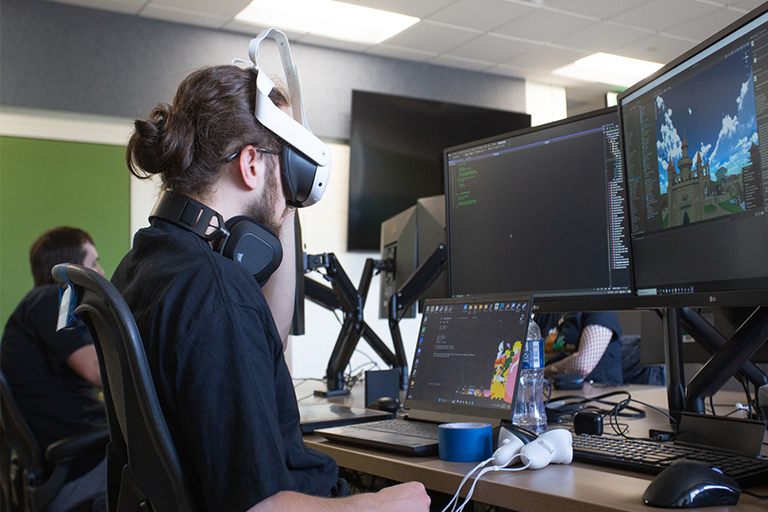Scholars in Michigan State University’s SPARTIE and GEL Labs are breaking new ground in how we teach, learn and collaborate — pushing the boundaries of XR technology across academic disciplines to explore the full potential of interactive, immersive experiences.
Virtual reality meets real learning: inside MSU’s innovative XR labs
At Michigan State University, scholars in two research labs are breaking new ground in how we teach, learn and collaborate. The Social and Psychological Approaches to Research on Technology-Interaction Effects (SPARTIE) Lab and the Games for Entertainment and Learning (GEL) Lab, both housed in the Department of Media and Information, are leveraging the power of extended reality (XR) technologies — including virtual reality (VR), augmented reality (AR), and mixed reality (MR) — to explore new frontiers in education and communication.
While each lab has its own distinct focus, they share a commitment to creating transformative learning experiences, exploring the psychology of digital interaction and fostering collaborations that bridge academic disciplines. Together, SPARTIE and GEL Labs are working to reshape the educational landscape and drive innovation across MSU and beyond.
SPARTIE Lab: social VR and enhanced learning
The SPARTIE Lab, led by Associate Professor and AT&T Endowed Chair Rabindra (Robby) Ratan, centers on the social dimensions of virtual reality, particularly in educational contexts. Ratan teaches his classes entirely in VR, using platforms like Engage and outfitting students with Quest 2 headsets to participate in a fully immersive learning environment. This approach goes beyond the limitations of traditional video conferencing, allowing students to feel more connected and engaged with both their peers and instructors.
“We look at how social presence — that sense of feeling like you’re ‘there’ with other people — influences perceived learning and actual learning,” explained Ratan. “And the fundamental story is that, yes, a VR class is way better than Zoom.”
His research highlights how students in VR settings not only report higher satisfaction but also perceive greater competency compared to more conventional Zoom classes.
One of SPARTIE’s core findings is that there is an optimal duration for VR engagement. “We found that about 30 minutes is, empirically, the inflection point,” Ratan said. “After about 30 minutes, people start to feel fatigued, and you get diminishing returns.”
This insight is critical for educators looking to integrate VR in a way that maximizes student outcomes without overwhelming participants or making them feel nauseous.


Photos: Teaching With VR workshop at Michigan State University.
Beyond VR, the SPARTIE Lab is also investigating the potential of mixed reality. Ratan’s ongoing work with MR headsets, like Apple’s Vision Pro, explores how these technologies influence social interactions and how they can facilitate a sense of social connection to people … or social absence from people.
One study, for instance, examines how users feel when engaging with a virtual avatar yoga instructor in both mixed reality and virtual reality environments, comparing the psychological impacts of these new forms of interaction.
“The hypothesis is that when the virtual instructor is here, and I’ve been passed through so I can see the whole room around me, the avatar is the only virtual thing, I’ll actually feel like the instructor has come to the room with me,” Ratan said. “Whereas if I’m seeing the whole room virtually, then I feel like we’re both in a new, virtual space together — which might not lead to as much social presence as if the instructor comes to me, in the room where I was already sitting.”
For Ratan, the other interesting question in this study is: to what extent does a person feel connected or disconnected to the human researcher who’s physically in the same room?
“In VR, I don’t see them at all. In pass through, I do see them … They’re a real human. And I’m talking to an avatar, who’s taking me through this virtual experience,” he explained. “I’m very curious if I actually feel closer to the virtual human, the avatar, than I do the real human who’s right there. Because that’s ironic and scary when you frame it in that way.”
GEL Lab: Game Development and XR for Education
While SPARTIE focuses on social XR, at the GEL Lab, Professor Brian Winn and Professor of Practice Andrew Dennis are applying game design expertise to XR research projects.
“Most of the GEL Lab projects have been a partnership between us, who represent the expertise to craft and build games, including XR experiences, and other faculty at MSU who bring their own domain of expertise,” said Winn, director of the GEL Lab. “These sorts of partnerships give us a competitive advantage at MSU when pursuing grants. Collectively, we can design, develop and research to advance a field forward. This has definitely been the case when it comes to redefining education and collaboration using XR.”
Dennis, who is the lab’s creative director and teaches game development at MSU, emphasizes that VR experiences are deeply intertwined with game design principles — especially when it comes to creating interactive simulations for learning.
“As a game developer, people ask me, ‘Oh, you do games? Do you also do VR?’ And I actually flip that and say, ‘You can’t do VR without games’ ... Everything that runs on VR runs off game technology,” Dennis said.
It's not just that games are a popular output for VR. Dennis explained that the techniques used for the real-time visualization and interactivity that make VR possible are all game standard. To build anything in VR that is interactive and not static, it must be developed in 3D — specifically, a form of 3D that can work in real-time. The necessary tools for this job are game engines, like Unreal Engine or Unity.


Photos: Students create virtual reality environments in the GEL Lab.
Mastery of this foundation allows the GEL Lab team to build immersive simulations that can be applied across a wide range of disciplines. For instance, the GEL Lab recently collaborated with multiple departments at MSU to develop a VR curriculum for health care professionals as part of a grant from the National Cancer Institute. Similarly, projects like the VESTA Virtual Vineyards simulation demonstrate how interactive, hands-on experiences can deepen students’ understanding of complex topics. By creating safe, controlled environments, students can practice skills and experiment in ways that might not be possible in a traditional classroom.
Dennis believes education should be more than just memorizing facts, figures and dates — it’s about experiencing knowledge through interactive, hands-on learning. However, there are challenges with creating fully immersive XR experiences. In a traditional video game, players generally do not expect every object to be interactive. That is not the case with virtual reality.
“With VR, we’re putting you in this place where you’re feeling functionally like, I should be able to press that button. I should be able to lift every object. If I throw this, it should do something,” Dennis explained. “And if I could grab everything, it’s too much for the computer to handle. So, there’s this kind of weird incongruity of it’s too much of a reality.”
It's a balance to make VR to look as good as possible, and still be capable of rendering in real time to provide the illusions of movement and presence. “If you get below about 70 [frames per second] that’s when people start getting sick. That’s when it starts getting really choppy, when it starts becoming like it’s not real,” Dennis said.
Collaboration and the future of XR at MSU
One of the most exciting aspects of the SPARTIE and GEL Labs is their desire to collaborate — both within MSU and with external institutions.
“I’m open to collaboration with organizations that are interested in meeting and teaching with VR,” Ratan said. “I think we can have mutually beneficial symbiotic projects that share data, or that are specifically oriented toward use cases that people find challenging, or they want to explore. Or if they just want some high-level feedback on what they’re doing. I’m happy to be involved in those types of collaborations externally.”
Ratan has already established partnerships with several institutions, including Stanford University and the University of Oregon, working on projects that address equity, inclusion and social well-being in virtual environments. The NSF-funded Beyond Meet Space project, which seeks to reimagine virtual meetings to improve engagement and collaboration, is one such initiative.
It was also a perfect opportunity for SPARTIE Lab to partner with the GEL Lab.


Photos: The SPARTIE Lab crew previews the Beyond Meet Space platform.
Dennis’s team worked to create the project’s virtual shared space such as one would have in an office, intended to serve as the ultimate replacement for remote working. Participants can move around within the space, go to different locations and break into smaller groups. “And you have proximity voice: the closer you get to something, the louder you hear it,” Dennis said.
The GEL Lab also encourages project leads to contact them about including game or XR development in research proposals. Developing interactive simulations that can serve as training tools or educational platforms is squarely in their wheelhouse. “What VR largely is right now is a solution without a problem. What are we trying to solve?” Dennis challenged, adding that his dream project might involve cognitive behavioral therapy.
“Each game is different; each project is different. Each team is different, the needs are different. The process is roughly the same,” Dennis said. “It is evaluating — what are the goals, what are we trying to do? What is the approach to solving those problems going to be? And then as a game developer, I’ve got my box of tools that I can use for that. And from the content expert, it’s trying to understand how can I solve their problems with my box of tools? But I need to understand their problem first. That’s the real brain bender of the job. That’s what I like about it.”
As XR technologies continue to evolve, the work being done at MSU’s SPARTIE and GEL Labs represents a glimpse into the future of education. Through their collaborative research efforts and focus on enhancing learning outcomes, both labs are helping to define the role that XR will play in shaping how we teach, learn and communicate in the digital age.
By Jessica Mussell
Research and collaboration
From exploring the psychology of virtual interactions to building cutting-edge simulations that bring complex concepts to life, these labs invite educators and researchers to join them in their mission.
GEL Grantcubator
If you are interested in game or VR development in your next grant proposal, please request consultation from the GEL Lab in the early stages of planning.
If you are interested in our research on the Proteus Effect, virtual meeting support for enhanced well-being and equity, teaching in VR, human-agent interaction, or mixed reality effects, please contact Robby Ratan at the SPARTIE Lab.




